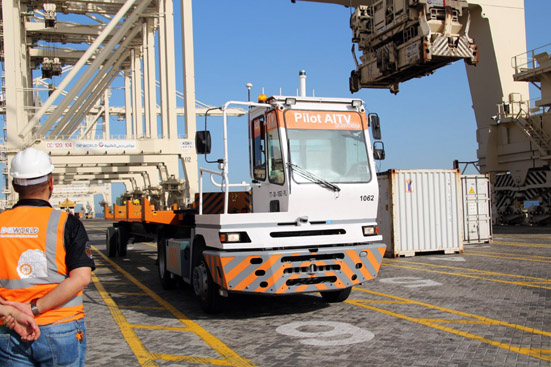Rajant and Velodyne power AVs at Dubai Jebel Ali port
- June 30, 2020
- Steve Rogerson

US firms Rajant and Velodyne Lidar have produced the technology behind the deployment of autonomous vehicles at DP World’s Jebel Ali port, the world’s ninth busiest seaport, in Dubai.
The two companies are playing a vital role behind the agreement between DP World, UAE Region and the autonomous vehicle, robotics and artificial intelligence specialist DG World. The contract will equip a fleet of DG World’s autonomous internal terminal vehicles (AITVs), including integration into the existing operational processes and infrastructures.
This deployment supports DP World’s strategy for future-proofed, seaport digitalisation setting a global standard for port operations, supply chains and trade.
Rajant’s fully mobile M2M Kinetic Mesh and BreadCrumb wireless nodes, along with Velodyne’s Puck 3D lidar sensors, enable DG World to deliver and integrate their autonomous technology into the existing ITV fleet in multiple phases. DG World’s goal is to increase the operational efficiency of the terminal and reduce the overall size of the currently used fleet.
“We trialled other wireless technologies, including the latest 5G, before discovering Rajant,” said Matthias Krause, general manager at DG World. “They all had the same physical limitation, which is that wireless cannot go through large, metal container stacks. Rajant’s Kinetic Mesh M2M technology allows the vehicles to talk to each other, which is critical to communicate fleet directions between container stacks. Velodyne Lidar has proven that their sensors are delivering unmatched data and can handle even harsh environments without problems, so it was an obvious choice. Both Velodyne and Rajant provided local support to ensure the project was a success. We have been impressed with their professionalism and extra support over the last several years.”
Puck sensors will provide computer perception data to help determine the safest way to navigate and direct AITVs in the complex, busy DP World seaport. The Rajant wireless mesh network provides a continuous communications infrastructure to ensure the AITVs are always interconnected and working together.
“Velodyne is honoured to be selected to help fully automate terminal vehicle transport at Jebel Ali Port, the premier port in the Middle East,” said Erich Smidt, executive director at Velodyne Lidar. “This exciting initiative will enable port terminal vehicles to work fully autonomously without drivers in a hectic, crowded environment. We want to thank our valued partner DG World for their vision in how Velodyne’s 3D lidar sensors can power automated guided vehicles (AGVs) that provide a quantum leap in port terminal automation in the region and beyond.”
Geoff Smith, Rajant’s executive vice president, added: “Selecting Rajant Kinetic Mesh to serve as the backbone for DG World and DP World Jebel Ali port really highlights the difference between Rajant M2M Instamesh technology and wifi, 4G and 5G. We are pleased to be chosen to make this AITV fleet deployment possible. Rajant is the only industrial wireless network for mobile machine-to-machine communication, which is also capable of overcoming RF signal blockages of large metal containers and signal interference from ships, radar and neighbouring ports.”
An MTi series industrial motion tracker sensor from Dutch firm Xsens supports the simultaneous localisation and mapping function, and AI-based real-time decision-making software. It combines a GNSS satellite receiver and an inertial navigation system in an industrial-grade package. This enables DP World’s AITVs to track their position accurately and navigate the AITVs, even when GNSS satellite signals cannot be received properly. This is an important capability when operating in a container port, since the AITVs will navigate through narrow corridors between tall stacks of containers that block the GNSS signals.
“Xsens is honoured to be selected by DG World to support this autonomous vehicle project and take it from concept to reality,” said Meindert Zeeuw, Xsens sales director. “This shows the advantages of using the Xsens MTi series with reliable sensor fusion algorithms developed in 20 years of Xsens existence, for real-time operation of industrial AGVs and UGVs in difficult circumstances.”
Headquartered in California, Velodyne is known for its portfolio of lidar sensor technologies. Founder David Hal invented real-time surround view lidar in 2005 as part of Velodyne Acoustics. This invention changed perception and autonomy for automotive, new mobility, mapping, robotics and security.
Rajant provides private wireless networks powered by the patented Kinetic Mesh network, BreadCrumb wireless nodes and Instamesh networking software. The company is headquartered in Malvern, Pennsylvania, with facilities and offices in Arizona, Kentucky and Alabama.




